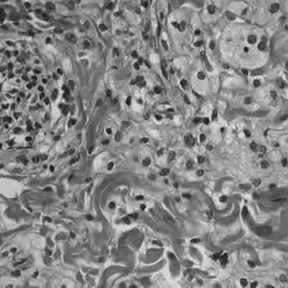|
|
| (14 intermediate revisions by one other user not shown) |
| Line 16: |
Line 16: |
| {{CMG}} | | {{CMG}} |
|
| |
|
| {{SK}}Erdheim-Chester syndrome; polyostotic sclerosing histiocytosis | | {{SK}} Erdheim-Chester syndrome; polyostotic sclerosing histiocytosis; ECD |
|
| |
|
| ==Overview== | | ==[[Erdheim-Chester disease overview|Overview]]== |
| '''Erdheim-Chester disease''' is a rare form of non-[[Langerhans cell|Langerhans-cell]] [[histiocytosis]]. Usually, onset is in [[middle age]]. The disease involves an infiltration of [[lipid]]-laden [[macrophages]], multinucleated giant cells, an inflammatory infiltrate of [[lymphocyte]]s and [[histiocyte]]s in the [[bone marrow]], and a generalized [[sclerosis]] of the long bones.<ref>{{cite web | title = Erdheim-Chester disease at the Disease Database | url =http://www.diseasesdatabase.com/umlsdef.asp?glngUserChoice=29792 | accessdate = 2007-03-25 }} </ref>
| |
|
| |
|
| ==History== | | ==[[Erdheim-Chester disease historical perspective|Historical Perspective]]== |
| The first case of ECD was reported by W. Chester and [[Jakob Erdheim]] in 1930.<ref>{{WhoNamedIt|synd|2412}}</ref>
| |
|
| |
|
| ==Clinical Presentation== | | ==[[Erdheim-Chester disease pathophysiology|Pathophysiology]]== |
| ECD affects predominantly adults, with a mean age of 53 years.<ref name="pmid8965684">{{cite journal |author=Veyssier-Belot C, Cacoub P, Caparros-Lefebvre D, ''et al'' |title=Erdheim-Chester disease. Clinical and radiologic characteristics of 59 cases |journal=Medicine (Baltimore) |volume=75 |issue=3 |pages=157-69 |year=1996 |pmid=8965684 |doi=}}</ref>
| |
|
| |
|
| Long bone involvement is almost universal in ECD patients and is bilateral and symmetrical in nature. More than 50% of cases have some sort of extraskeletal involvement. This can include kidney, skin, brain and lung involvement, and less frequently retroorbital tissue, pituitary gland and heart involvement is observed.
| | ==[[Erdheim-Chester disease causes|Causes]]== |
| Bone pain is the most frequent of all symptoms associated with ECD and mainly affects the lower limbs, knees and ankles. The pain is often described as mild but permanent, and juxtaarticular in nature. [[Exophthalmos]] occurs in some patients and is usually bilateral, symmetric and painless. In most cases it occurs several years before the final diagnosis.
| |
|
| |
|
| A review of 59 case studies by Veyssier-Belot, C et al. in 1996 reported the following symptoms in order of frequency of occurrence:<ref name="pmid8965684"> </ref>
| | ==[[Erdheim-Chester disease differential diagnosis|Differentiating Erdheim-Chester disease from other Diseases]]== |
| *[[Bone pain]]
| |
| *[[Retroperitoneal fibrosis]]
| |
| *[[Diabetes insipidus]]
| |
| *[[Exophthalmos]]
| |
| *[[Xanthomas]]
| |
| *[[Neurology|Neurological]] signs (''including [[Ataxia]]'')
| |
| *[[Dyspnea]] caused by interlobular septal and [[pleura]]l thickening.
| |
|
| |
|
| ==Histology== | | ==[[Erdheim-Chester disease epidemiology and demographics|Epidemiology and Demographics]]== |
| Histologically, ECD differs from Langerhans cell histiocytosis (LCH) in a number of ways. Unlike LCH, ECD does not stain positive for [[S-100 protein|S-100]] or [[CD 1a]], and electron microscopy of cell cytoplasm does not disclose [[Birbeck granules]].<ref name="pmid8965684"> </ref> Tissue samples show xanthomatous or xanthogranulomatous infiltration by lipid-laden or foamy histiocytes, and are usually surrounded by fibrosis. Bone biopsy is said to offer the greatest likelihood of reaching a diagnosis.
| | |
| | ==[[Erdheim-Chester disease natural history, complications and prognosis|Natural History, Complications and Prognosis]]== |
|
| |
|
| ==Diagnosis== | | ==Diagnosis== |
| Radiologic osteosclerosis and histology are the main diagnostic features. Diagnosis can often be difficult because of the rareness of ECD as well as the need to differentiate it from LCH. A diagnosis from neurological imaging may not be definitive. The presence of symmetrical cerebellar and pontine signal changes on T2-weighted images seem to be typical of ECD, however, multiple sclerosis and metabolic diseases must also be considered in the differential diagnosis.<ref>{{cite journal | last = Weidauer | first =S. | coauthors =von Stuckrad-Barre S., Dettmann E., Zanella F.E., & Lanfermann H. | title =Cerebral Erdheim-Chester disease: case report and review of the literature. | journal = Neuroradiology | volume =45 | pages =241-245 | date =2002}}</ref>
| | [[Erdheim-Chester disease history and symptoms|History and Symptoms]] | [[Erdheim-Chester disease physical examination|Physical Examination]] | [[Erdheim-Chester disease laboratory findings|Laboratory Findings]] | [[Erdheim-Chester disease electrocardiogram|Electrocardiogram]] | [[Erdheim-Chester disease x ray|X Ray]] | [[Erdheim-Chester disease CT|CT]] | [[Erdheim-Chester disease MRI|MRI]] | [[Erdheim-Chester disease echocardiography or ultrasound|Echocardiography or Ultrasound]] | [[Erdheim-Chester disease other imaging findings|Other Imaging Findings]] | [[Erdheim-Chester disease other diagnostic studies|Other Diagnostic Studies]] |
| | |
| ECD is not a common cause of exophthalmos but can be diagnosed by biopsy. However, like all biopsies, this may be inconclusive.<ref name="Mdanderson"> {{cite web |url=http://www.mdanderson.org/diseases/eyecancer/display.cfm?id=5423a04c-459e-4e12-a737309ef2e1e299&method=displayfull |title=Erdheim Chester Disease - M. D. Anderson Cancer Center |accessdate=2007-08-26 |format= |work=}}</ref>
| |
|
| |
|
| ==Treatment== | | ==Treatment== |
| Current treatment options include:
| | [[Erdheim-Chester disease medical therapy|Medical Therapy]] | [[Erdheim-Chester disease surgery|Surgery]] | [[Erdheim-Chester disease cost-effectiveness of therapy|Cost-Effectiveness of Therapy]] | [[Erdheim-Chester disease future or investigational therapies|Future or Investigational Therapies]] |
| *Surgical [[Debulking]]
| |
| *High-dose [[Corticosteroid]] therapy
| |
| *[[Cyclosporine]]
| |
| *[[Interferon]]-α<ref name="Mdanderson"> </ref>
| |
| *[[Chemotherapy]]
| |
| *[[Radiation therapy]]
| |
| All current treatments have had varying degrees of success.
| |
| | |
| The [[vinca alkaloids]] and [[anthracyclines]] have been used most commonly in ECD treatment.<ref>{{cite journal|last=Gupta |first=A.|coauthors=Kelly, B. & McGuigan, J.E.|title= Erdheim-Chester disease with prominent pericardial involvement.|journal=American Journal of Medical Science|volume=324|pages=96-100|date=2002}}</ref>
| |
| <!-- Use the following categories
| |
| ==Prognosis==
| |
| ==Further Reading==
| |
| ==External Links==
| |
| -->
| |
|
| |
|
| ==References== | | ==Case Studies== |
| {{Reflist|2}}
| | [[Erdheim-Chester disease case study one|Case #1]] |
|
| |
|
| {{Hematology}} | | {{Hematology}} |
